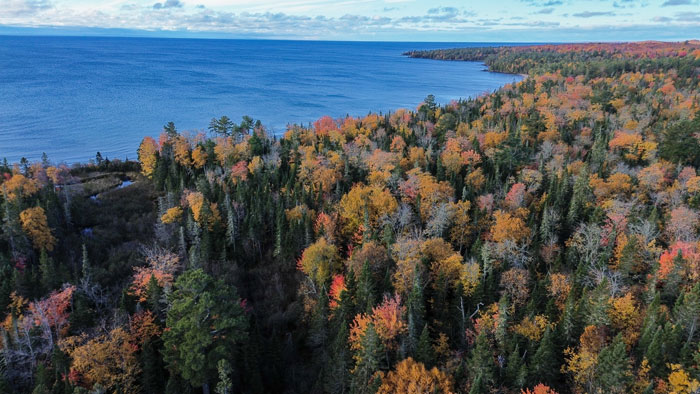Whether we’re talking about rocky switchbacks that lead to a breathtaking vista or a paved pathway that loops around a city park, it’s fairly easy to define what a trail is, in terms of its most basic function. Simply put, a trail is a route planned or followed for a particular purpose.
But what, by definition, constitutes a “great” trail—one that rises to the level of a community asset and an area attraction that people return to time and again?
We put the question to world-renowned trail-design expert Drew Perkins, who worked on projects from Alaska to Austria before joining the California-based nonprofit Santa Cruz Mountains Trail Stewardship in 2018 as its trails planning director.
Delivered with shrug and a smile, his response was succinct but far from simple: “It depends.”
Indeed, it does.
People use trails for a variety of reasons, in search of a range of experiences and emotions. Some seek serenity. Some crave adventure. Some come for exercise, while others take their sweet time—all the better to take in the sights.
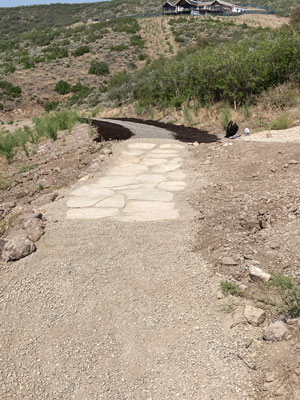
“Everyone’s looking for something different when they’re on a trail,” Perkins said. “The challenge for trail system planners and builders is to provide as many different opportunities as you can. If your entire trail system is 20 miles of the same thing, I don’t think that’s very valuable to the community.”
Even if we can agree that all trail users share the intent of “covering some ground,” effective trail development goes beyond providing miles of trails, putting as much or more emphasis on quality over quantity. And, as Perkins pointed out, what makes for a quality trail depends on a lot of factors, including users’ desired method of locomotion—on foot, on wheels, perhaps even on horseback. Because those factors are so far-ranging, this article focuses on hard-surface multiuse community trails, which often fall under a park district’s purview. (Single-purpose or backcountry trails for backpackers, mountain bikers, equestrians and all-terrain vehicles have specialized design considerations and often entail multijurisdictional involvement and other complexities that are beyond the scope of this discussion.)
Effective trail development is a journey that starts indoors at the proverbial drawing board. Every journey is different but generally leads off with the same steppingstones:
- Careful and extensive planning, based on stakeholder input.
- Design features and construction methods aimed at achieving environmental, economic and social sustainability.
- Experiential features and trail amenities that meet the needs of identified user groups and create a unique sense of place.
No matter the location or the intended use, trails that best serve communities and stand the test of time all arrive at the same endpoint: the enjoyment of high-quality recreational experiences in landscapes that are capable of supporting them.
Planning for Success
Encountering the unexpected can be a delightful part of trail use and exploration. However, it is not a desirable aspect of the trail design and development process. Just as an experienced backpacker would never hit the trail without a map and an itinerary, trail design should never commence without a comprehensive plan.
“Trail” is not just a noun but also a verb, meaning to follow in someone’s footsteps. To be clear, communities looking to build a trail or expand their trail network will inevitably encounter some unanticipated problems along the way. Whether designing a standalone, in-park trail or a trail segment that’s ultimately intended to join other trails built in phases to form an interlinking, community-wide trail system, there are experts for hire and online guides to help you skirt around potential pitfalls. A good place to start is the online Trail Planning and Design Hub of American Trails, a nationwide coalition of trails organizations. The hub links to free guides and webinars covering a range of issues that arise and steps to accomplish as part of the trail planning process, such as work permit requirements, easement and land acquisition, and topography and hydrology analysis.
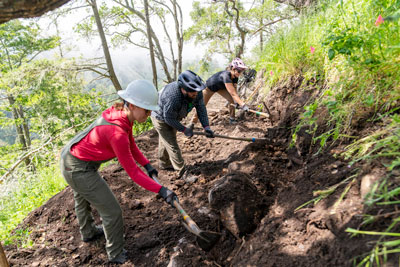
As Tracey Paradise, writing for Trail Builder Magazine, explained it: “The journey of trail building begins long before the first shovel hits the ground. It starts with visionaries who study the lay of the land and its natural features. This phase involves a series of approvals, meticulous planning, and taking into account factors like slope, terrain, soil type, and drainage.”
This article assumes that preconstruction phases such as a community needs assessment, site selection and ecosystem analysis have been completed, and that the design team is poised to proceed to the third steppingstone of effective community trail development: incorporating features and amenities that provide an enjoyable and safe experience while minimizing environmental impact. However, there is one overarching concern—sustainability—that guides every aspect of trail design, from initial planning to routing and construction and ever onward, throughout generations of ongoing maintenance. Sustainability as a guiding principle determines whether a trail remains durable, usable and engaging.
Sustainable and Maintainable
“There are different spheres of sustainability, and often what comes to mind first is physical sustainability—that is, how does the actual trail tread and corridor hold up to the intended amounts and types of use?” said Jeremy Wimpey, principal of the full-service outdoor recreation firm Applied Trails Research, based in Staunton, Va.
Another of Wimpey’s sustainability “spheres” is ecological sustainability, or effectively integrating the trail with the existing ecosystem. This involves the protection and preservation of natural resources, keeping in mind that well-designed, well-defined trails within sensitive ecosystems can actually help protect the environment by discouraging off-trail wandering.
A third sphere, managerial sustainability, takes into account the available resources for ongoing operations and maintenance. A trail should be easily and affordably maintainable by park staff using standard maintenance vehicles and equipment, to a condition that it not only remains safe and passable but also inspires a sense of stewardship among users.
Last but not least, “The sustainability goal that we really focus on with the communities we partner with is social sustainability, which is all about providing the right mix and range of experiences for folks and accommodating multiple uses on the landscape,” Wimpey said.
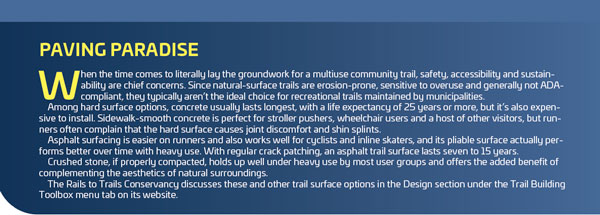
Socially sustainable trails should not be mistaken with “social trails,” which are formed when people disregard designated trails for any number of reasons. As it happens, designing trails with social sustainability in mind goes a long way toward preventing the formation of unofficial, user-created “social trails.” That’s because socially sustainable trails, by definition, “accommodate visitor demands for access to popular and iconic destinations, and also support a variety of recreational trail activities and experiences to meet the needs of different users,” according to the U.S. Geological Survey. In other words, folks don’t have to forge their own path in search of their desired experience.
A community’s trail system as a whole “might look at providing a good trail running experience, a good bird watching experience, a good mountain biking experience, and a nature or cultural immersion experience, with maybe an educational or interpretive opportunity associated with that,” Wimpey said.
An Adventure Divided Into Chapters
Designing for social sustainability ensures that a community trail will be used, enjoyed and stewarded. While it’s often said that life is not about the destination but the journey, a well-designed trail is about both. While some trails—particularly out-and-back trails—highlight a spectacular destination, all trails should have points of interest along the way. Not all communities boast a natural wonder like a cascade waterfall or vertiginous mountaintop, but most offer something worth pausing to behold, be it a majestic old tree, a patch of wildflowers or a site of historic significance.
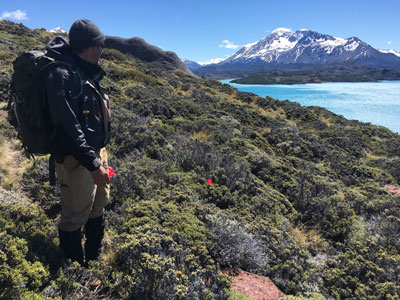
In trail routing, these attractive features, intended to be encountered and experienced, are called positive control points. Trail designers also take stock of negative control points—areas or elements that resource managers want folks to avoid, such as sensitive habitats, hazardous terrain or powerlines.
Control points provide a design framework for the trail, usually resulting in a pleasing nonlinearity. In any case, trails should incorporate curves to avoid a long, straight, monotonous “interstate effect,” said Scott Linnenburger, a principal at Boulder, Colo.-based Kay-Linn Enterprises, which provides technical and strategic assistance in the fields of recreation, conservation, education, and community health and well-being. “Even in an open park-like situation, people react better to curves and changes in their line of sight.”
Positive control points also include human-made features—like seating or viewing decks—or purpose-built destinations such as a playground or picnic pavilion. Any fabricated elements along a trail should fit in with the setting and result from “thinking about what people in the community might enjoy in their trail experience—things that would extend their time and level of enjoyment within the park,” Linnenburger said.
The city of Longview, Texas, maintains a system of trails that will eventually interconnect, providing different amenities and varying terrains on each segment, including a concrete trail with a good amount of tree canopy as well as a narrower, undulating asphalt trail. Amenities along the trails include a small-dog park and an adjacent but separate large-dog park, a disc golf course, public art installations (including two made out of decommissioned road signs), play structures, and a series of trailside fitness stations for circuit training. One cherished aspect of the trail system is a user-created “sharing tree,” where visitors take and leave small gift items, like strings of beads or plastic action figures, in the hollowed-out trunk. With a hand-scrawled wooden sign denoting its purpose, it stands as an exception to “leave no trace” etiquette.
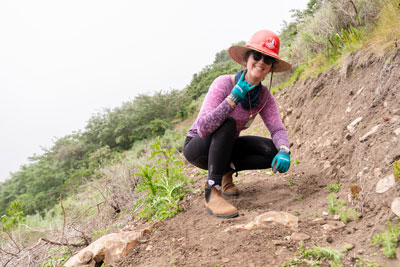
As for the spacing of positive control points, “I think in a community park situation, they should be at quarter-mile intervals,” Linnenburger said. “You may have people using the trail for physical rehabilitation or who are starting to exercise or who just want to relish the experience of being outside, and this provides some structure so they can walk a bit and then pause to sit for a few minutes or enjoy a scenic overlook. It’s way more interesting and rewarding than walking laps around a track.”
Some seemingly desirable amenities are actually frowned upon by certain parks agencies due to high maintenance requirements, impracticalities and the potential for vandalism. San Jose, for example, generally does not provide bike repair stations; however, the city allows private businesses to fund and maintain them.
Some trail designers warn against erecting too much signage, as it can create visual clutter and detract from the natural environment, according to Bob Radke, founder of Park City, Utah-based Creative Trails, a turnkey provider of trail-related services. However, wayfinding and interpretive signage can augment user safety and enjoyment. Milestone markers are a must-have and are generally installed at quarter-mile intervals on urban trails to help users track their distance and also help responders locate trail users in need of assistance or address reported trail hazards.
Positive control points also include basic creature comforts and conveniences, such as restrooms, water fountains, picnic tables, shade structures, doggie-bag dispensers and waste receptacles, many of which are best located at trailheads—which is arguably the most determining factor in attracting visitors, as we shall soon discuss.
A Sense of Place
A good trail is more than just a scenic route. A good trail creates a unique sense of place and sometimes captures the spirit and aesthetic of the surrounding community. For example, in Bend, Ore., some local trail intersections are roundabouts encircling sculptures, mimicking the look of the town’s streets.
Public art on trails also reflects a community’s identity. In Cary, N.C., a local artist worked with elementary school students to design decorative fencing along a trail.
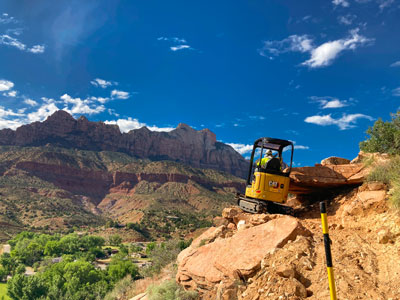
Wimpey cited several instances in which communities have gotten creative in establishing not only a unique sense of place but also an interactive user experience. Parts of Baileys Trail System in Chauncey, Ohio, has been converted into a storybook trail, “so it’s like a story that unfolds as you go around, getting immersed not only in the landscape but in this book-like type of experience” created in cooperation with the local library, Wimpey said.
In Bellemont, Ariz., the Barefoot Trail is a mile-long stretch of manicured trail interspersed with different textural experiences—smooth steppingstones, sand and soil, soft grass, and even mud. “It’s pretty neat to see people take their shoes off and experience nature through the soles of their feet,” Wimpey said.
Creating a positive trail experience and a distinctive sense of place starts at the trailhead. Like the cover and foreword of a book, the trailhead gives users an overall feel for the trail’s design and character. One of the biggest potential attractions or deterrents is the amount of available parking. “I visit trails in every community I go to—that’s how I spend my vacations—and I’ve seldom seen a trailhead that has enough parking when the place gets busy,” Radke said. “I think it’s key, in the planning phase, to determine your parking needs so you aren’t unintentionally turning people away or causing problems with cars parking offsite in front of people’s houses.”
Another trailhead commodity that’s often done poorly, in Wimpey’s opinion, is the informational kiosk. “When kiosks are done well, they’re really a key part of the experience, attracting and welcoming people and providing mapping and other useful information,” he said. “It’s an engagement tool for users—a chance to interact with them.”
Kiosk and other trailhead signage might include, at a minimum, the trail’s name, difficulty level and length in both distance and time, as well as park restrictions and regulations.
Use of decorative pavement, etched concrete, mosaiced seat walls, stone-clad columns and public art can make a trailhead especially attractive and inviting.
Taking the Long View
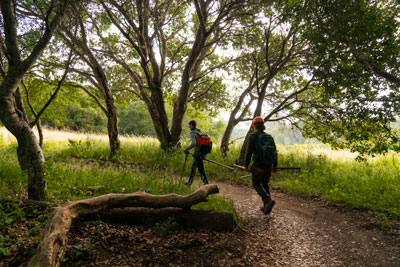
Lack of masterplanning and due diligence at the onset of trail development can cause problems down the line, including social unsustainability, user conflict and a short-sighted rather than holistic approach to trail system delivery. “I get why it happens—public demand for a trail is high and the funding is there, so they forge ahead,” Perkins said. “But when we think about trail systems, it’s all about providing a variety of experiences. Some people are looking for something flat and easy, and they call that a great trail. I mean, there needs to be a place where people can go with their kids and not get run over, right? Other people are looking for someplace really challenging to push themselves. If you try to do all of that on one trail, no one’s going to get what they really want.”
And too often, as trail development phases unfold, “I think a lot of times communities just look at, ‘How do we get from A to B or connect this park to these other parks?’ It’s more about creating a continuous line on the map, with not as much consideration given to the different types of experiences that can be provided for different types of users of those interlinking trails,” Perkins continued.
Asked again what separates a ho-hum trail from a humdinger of a trail, Perkins amended his original response: “It depends,” he repeated, “but it’s doable. You just need to be thoughtful about the different experiences people are looking for and find ways to provide them.” RM



